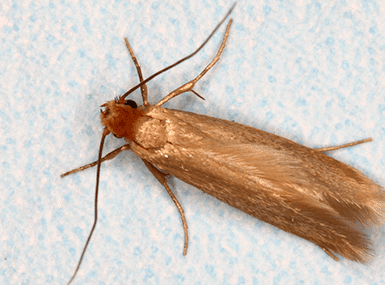One of the first things you need to know about case-making clothes moth is that they are unlike the moths that you see fluttering around light bulbs or invading pantries. There are thousands of varieties of moths; this one, however, is perhaps the sneakiest. You may never see one, but you will know they have been around by the holes they leave in your clothing and other fabric items. So, if you don’t want these pests wreaking havoc on your wardrobe you will have to read up on these case-making clothes moths.
Case-making clothes moths have long, narrow wings that are a brownish-gray color and sometimes have dark spots. They rarely fly, are usually about ½” in length and will stay hidden for the most part. Their larva is unique; it lives inside a case made of silk particles that it carries with it wherever it goes to eat and are responsible for most of your fabric damage. They have two eyes on either side of their head of their brown heads and have a creamy yellow grub-like look to them.
Case-making moths prefer silk, wool, and fur; however, contrary to the popular belief that they enjoy only natural fabrics, these moths will also feed on synthetics especially if it is soiled by oils or food. They can also invade carpets, natural bristle brushes, dry herbs, tobacco, animal mounts, and other products that contain some sort of fiber. They will remain hidden in quiet, dark places like in closets, storage, clothes bins, dresser drawers, and under carpets, especially if they are not frequently used. This makes detecting an infestation quite difficult.
Usually, after mating, the female moth will lay up to 300 eggs before she dies. In the winter, these eggs may take several weeks to hatch, but in the summer months, they can hatch within 4-10 days. The male moths will live for up to a month longer to mate with other females and as this cycle continues throughout the summer month the population can grow quite rapidly. Once the eggs hatch, they begin feeding right away; the larvae will thrive in ideal conditions where there is food, humidity, and warmth.
If you are looking to exterminate an infestation or prevent an infestation and fabric damages in your Davenport, IA home, you should contact a professional pest control service. Quik-Kill Pest Eliminators, serving Central and North Central Illinois, as well as Southwest Iowa, are experienced in all aspects of pest control. Give us a call and ask how we can help you with your case-making clothes moth questions, problems, elimination, and prevention.

